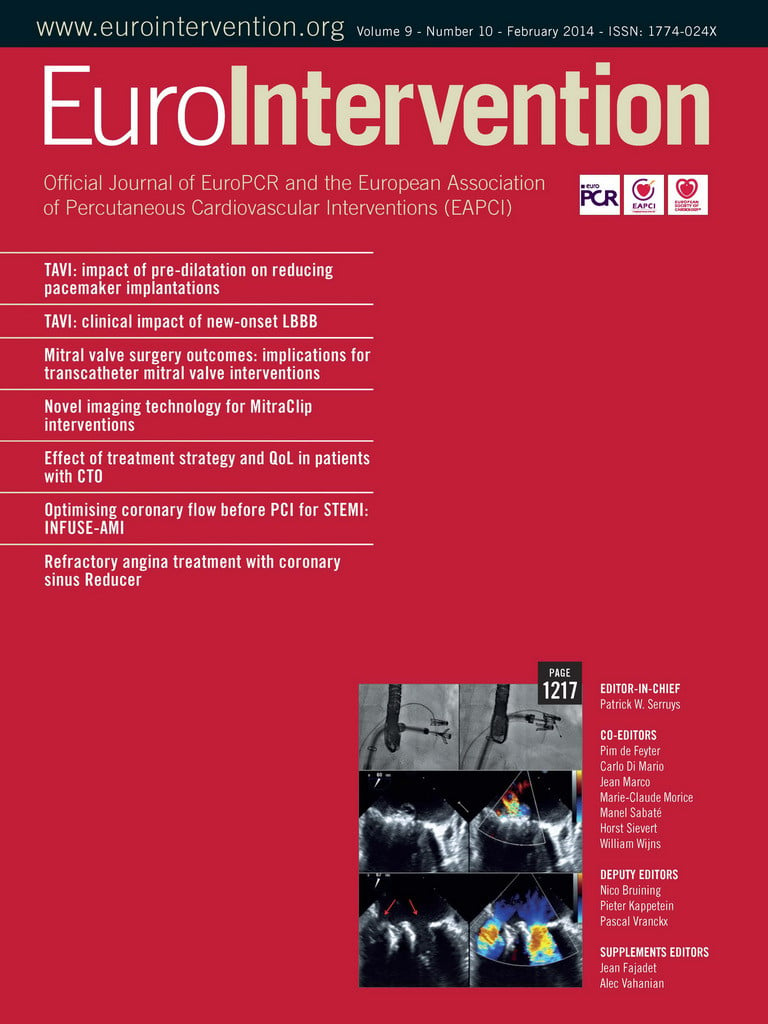Chronic total coronary occlusions (CTO) are present in about 20% of patients with relevant coronary artery disease, >50% have well-preserved LV function and >80% have no Q-waves in the CTO territory, suggesting that the dependent myocardium is viable. The presence of a CTO on coronary angiography has a powerful impact on treatment decisions, resulting in more frequent referral to coronary artery bypass grafting (CABG) or sole medical therapy compared with when only stenotic lesions are present.
This is primarily due to the extremely difficult and time-consuming task of addressing CTO by percutaneous coronary intervention (PCI). Thanks to specific wires and sophisticated techniques continuously evolving since the early 1990s but, even more importantly, owing to a few strenuously enthusiastic CTO PCI advocates like O. Katoh, H. Tamai and T. Suzuki, as well as educational efforts by dedicated groups like the European CTO club1, the success rate has increased from about 50% to 90% in the hands of focused CTO operators. This was paralleled by a shift in long-term patency from <50% to >90% due to drug-eluting stents.
In several observational studies it has been shown that, upon successful reopening, angina will improve, functional tests will be normalised, LV function will improve and CABG will be avoided2-4. There is additional evidence that successful opening of a CTO will improve survival, especially in the presence of multivessel disease5-7. Unfortunately, the results of two randomised trials comparing optimal medical therapy with CTO PCI (Korea and Europe) are still pending and will not be available before 2017.
In this issue of EuroIntervention, a group from Canada adds further crucial information to clarify the uncertainty as to whether chronically occluded coronary arteries should be revascularised, and by which modality8. The authors compared a group of 387 consecutive stable patients with at least one CTO, treated in 2008/09. The patients were assigned to one of four treatment strategies, based on actual treatment intention, within 30 days of the index angiogram. One hundred and fifty-four underwent medical therapy, 83 had a minimalistic interventional approach, i.e., PCI to the non-CTO artery only, and the remaining patients underwent more aggressive treatment of the CTO and non-CTO territory: 104 by CABG and 46 by PCI. Different from earlier observational trials, the patients remained in the intention-to-treat category, even if the CTO PCI was unsuccessful or if the CTO area was not bypassed by CABG (20% in both groups ultimately did not have revascularisation of the CTO artery). Overall, >50% had a positive stress test, 54% had preserved LV function and only 13% had Q-waves in the CTO territory, figures that are similar to European experience of unselected CTO PCI patients9. The patients’ quality of life was evaluated applying the Seattle Angina Questionnaire and the EQ-5D score, recommended by the National Institute for Health and Clinical Excellence (NICE), specifically to assess the status of physical limitation, angina, disease perception, treatment satisfaction, mobility, self-care, usual activities, pain/discomfort and anxiety/depression. Comparing baseline to one year, when the potential effects of restenosis and time required for recovery from surgery are incorporated, the patients revealed statistically significant improvements in all treatment categories except medical therapy. Notably, this latter group was the one with the highest (best) score at baseline but with no significant change over one year. To my surprise, patients with PCI to the CTO were the only group to report improvements in treatment satisfaction over time. In the group with PCI to the non-CTO artery, which I describe as a “minimalistic approach”, the quality of life indices improved less than those of the more aggressively treated patients in the PCI to CTO and CABG groups.
Despite the acknowledged limitations of selection bias (only 12% received CTO PCI), this prospective cohort study undoubtedly reflects contemporary real-world treatment and in this way underscores that CTO revascularisation, either by PCI or CABG, significantly improves quality of life compared to medical therapy or to medical therapy plus limited revascularisation (of the non-CTO territory). The particular strength of this work is that the authors evaluated patients undergoing all potential treatment options, including PCI to the non-CTO artery, which is still far too often favoured by PCI operators not very familiar with CTO interventions.
The fact that the presence of a CTO is one of the major anatomic predictors for referral to CABG leads one to conclude that most cardiologists believe symptomatic CTOs should be revascularised. However, in the SYNTAX (Synergy between PCI with Taxus and Cardiac Surgery) trial, approximately one-third of the CTOs referred for CABG were not surgically revascularised10 and, more importantly, most grafts to CTO arteries other than the LAD will be occluded after one year11. Thus, it should not be taken for granted that simply referring a patient with CTO for CABG will be better than referring him to a dedicated CTO operator. My personal appreciation is that the reverse is true.
Apart from two profoundly mistaken arguments against CTO PCI – 1) “the OAT trial (Occluded Artery Trial) proves that CTO intervention is outgunned” (OAT was a non-CTO trial), and 2) “well developed collaterals are sufficient to supply the CTO territory” (sufficient in only 5%) – a reasonable objection is “the lack of randomised data”. The EuroCTO club and a group from Korea, who are both currently randomising patients with chronic stable angina to PCI versus medical therapy, are trying to close this gap. By December 2013 the EuroCTO trial had included about 220 patients, which is far less than 10% of its online registry. This ultra-slow recruitment reflects the dilemma of dedicated CTO operators, whose success rate is >85% with a <1% rate of major complications, to include symptomatic patients with relevant viable CTO territory. The present study of Wijeysundera and co-workers is grist to the mill of the majority of cardiologists who do not diligently comply with the results of randomised trials of highly selected patients but rather weigh the treatment benefit from the perspective of their patients.
Conflict of interest statement
The author has no conflicts of interest to declare.

